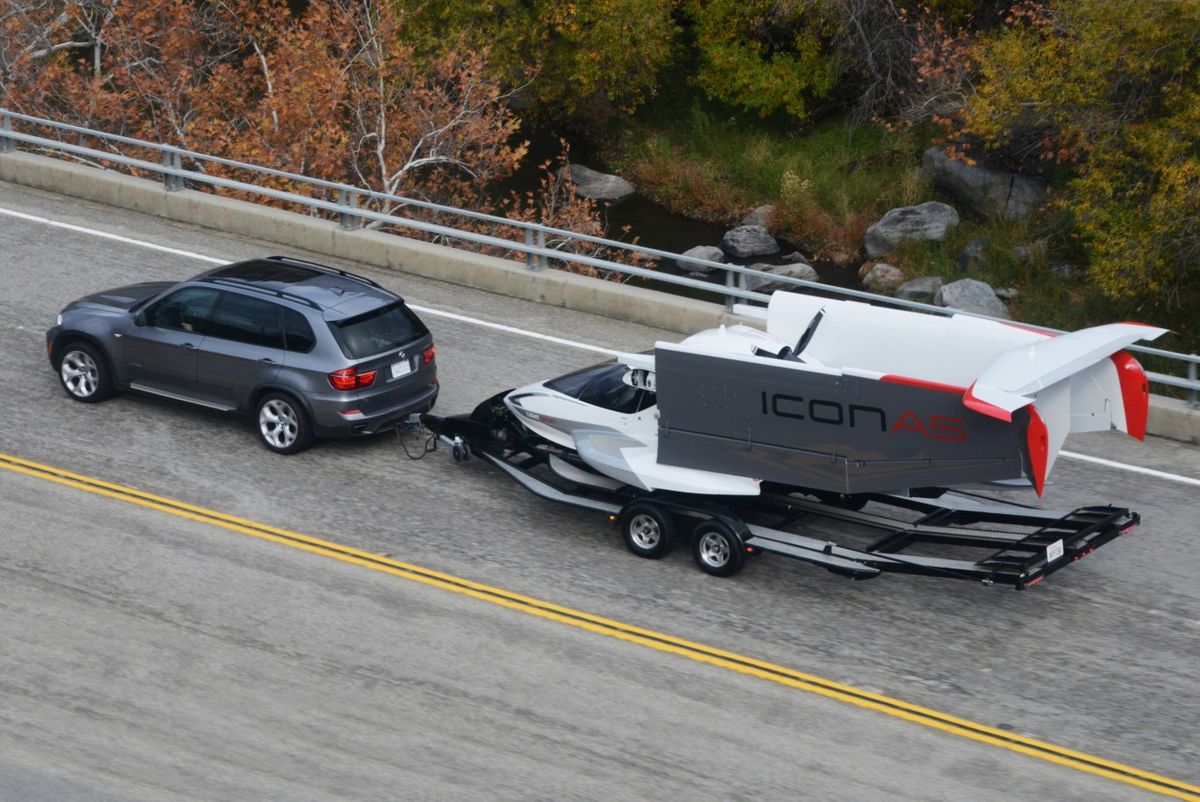The Icon A5 seaplane glides over the George Washington Bridge connecting New Jersey with Manhattan, high enough to keep drivers from getting nervous, but low enough that I can distinguish the colors of license plates. I’ve never seen the bridge from this angle. For a driver, the bridge’s long light of red brake lights signals a commuting nightmare — but from my vantage point, it just looks cool.
Funny what a change of perspective accomplishes, right?
An automotive corollary to Murphy’s Law would be that your journey will definitely be more miserable today than it was yesterday. So how’s this for a disruption? Flying for fun. Fewer rules. No TSA or security lines and little to no communication with authorities such as air traffic control. Have wings, will travel.
Following the broad lines of a sun-dappled Hudson River, my tiny two-seat aircraft is heading south toward the spires of the Financial District, a schlep that would take the gridlocked drivers below an agonizingly long time. I’m sitting in the left-hand bucket seat, a yoke in front of me and one arm dangling out of the open side window. I wave lazily at the traffic below.
Goodbye to all that. Because, by God, a “light sport aircraft” is the way to get around.
This is The Harper Spin, a weekly column from seasoned auto critic Jason H. Harper. He’s raced at Le Mans, crushed a car in a 50-ton tank, and now, he’s bringing his unique style to The Verge.
/cdn0.vox-cdn.com/uploads/chorus_asset/file/4252293/WING1824_retouch1-1280x854.0.jpg)
The A5 is a carbon-fiber seaplane that only costs $250,000. (Price is relative, granted, but we’re talking about a plane here.) You can learn how to operate it in less time than it takes to binge-watch two seasons of House of Cards. It is amphibious, taking off and landing from both land and water. And if things go really wrong, you can trigger an oversized parachute and float softly to the ground.
Icon wants to change the flying world by appealing to the person who might otherwise buy a Ferrari. Instead of going out for a Sunday afternoon drive, Icon promises, you can soar.
The company was founded in 2006 and recently moved to Vacaville, in Northern California, some 50 miles northeast of San Francisco. Its one and only product is the A5, which was first unveiled as a prototype in 2008 and recently gained certification of airworthiness from the FAA. Deliveries will start in earnest next year. Icon says it already has some 1,500 deposits and that the price will eventually drop to $197,000 for a base model.
The A5 is one of a new breed of plane, called Light Sport Aircraft (LSA), which are limited by weight, speed, and a maximum of two seats. The cabins are not pressurized, which makes the hardware simpler and limits altitude. The general idea is that LSAs are aircraft that are streamlined and easy to operate.
/cdn0.vox-cdn.com/uploads/chorus_asset/file/4252297/icon-a5-004-2040.0.jpg)
In an odd twist, it’s a government agency that pushed to make LSAs possible: we have the FAA to thank, according to Icon’s CEO and founder, Kirk Hawkins. “The industry has been over-regulated for many, many years. The FAA is actually trying to right that,” he says. In 2004, the agency opened the skies to LSAs, and also a less demanding level of license, called a Sport License. “The idea is to bring the fun back to flying,” says Hawkins.
You can qualify for a Sport Pilot License in as few as 20 hours of in-flight training. There are limitations, of course: these pilots cannot fly at night, in congested airspace, or in lousy weather. But incredibly, those restrictions don’t have much impact on the corridor up the Hudson overlooking New York City.
On a sunny fall morning, I arrived at a pier in northern Manhattan to find two A5s bobbing in adjoining slips. One look makes it clear that this is not regular plane. If the Cessna Skyhawk — in production in various forms since 1956 — is the Toyota Corolla of private planes, the A5 is a Porsche Cayenne. The shape is streamlined and svelte, with wings sprouting from the cockpit’s top rear. The carbon fiber prop is behind the wings. In all, it is a radical design, unlike any plane I’ve ever seen.
At 23 feet long, it’s also small, roughly the size of a crew-cab, long-bed pickup. It is 8.1 feet high with a modest wingspan of 34.8 feet. The landing gear retracts for water landings, and the wings fold so that it can be carried on a trailer. Because of its light weight (1,510 pounds), it needs only a 100-horsepower engine — a Rotax 912 — to propel it to a top speed of 110 mph and a range of up to 450 miles. It’ll even run on pump gas. (Imagine rolling up to your local Shell in one.)
/cdn0.vox-cdn.com/uploads/chorus_asset/file/4252299/DSC_32731-1280x855.0.jpg)
I drop into the cockpit next to Jeremy Brunn, a grinning Navy pilot who is the director of flight training at Icon. I promise him that it is impossible to get me air sick and that I really want to see how well the A5 maneuvers. He gives me a “we’ll see” look.
We push off the pier, turn on the prop, and navigate into the open water. Then Brunn pulls back on the A5’s stick and we skip on top of the water, avoiding a clump of questionable floating debris, and then lift effortlessly off. Quickly gaining altitude, we carom south, over the Hudson and toward the bridge.
It is breathlessly easy, totally drama-free, and requires no contact with an air traffic controller. No permission is needed from anyone, actually, as long as we adhere to specifically designated air spaces. (We had to take off north of the Bridge, for instance.) For the first time in a long time, the phrase “freedom of flight” has a ring of authenticity to it. I’m breathing real air up here, a far cry from the stuffy airliners we’re used to.
The western side of Manhattan opens up to our left, glass and steel glinting in the light. It almost feels illicit, as if we are getting away with something. We’re hundreds of feet above sea level, not thousands, and helicopters cross above us; jetliners glance across the sky above them. That’s when Brunn tells me to take the stick. I’ve flown a Cessna before (or, perhaps more correctly, “briefly controlled”), and the A5’s controls strike me as more finessed, more highly tuned. The yoke has a nice weight to it, and the plane makes altitude and lateral adjustments with slight pressure. Still, it’s not fidgety. And there are only nine gauges in front of me. Simple. I could learn to do this.
/cdn0.vox-cdn.com/uploads/chorus_asset/file/4252303/icon-a5-007-2040.0.jpg)
Brunn takes back over when we reach Lady Liberty, and we cartwheel around the statue as tourists on a Circle Line ship crane their necks. Then we head back north so that Brunn can show off the A5’s chops.
First on his list: a mid-air stall. If it’s controlled, a stall isn’t a problem at all — but it can also happen when a pilot gets things seriously wrong, mistakenly positioning the plane so that its wings are no longer getting lift. The result is a loss of altitude and sometimes all control, and a potential spiral. It is one of the leading causes of crashes among private aircraft.
Icon claims that the A5 is the world’s first plane with a “spin-resistant” design. Hawkins, the CEO, told me that this technology is baked into the overall design, and is the result of a series of engineering solutions. “I can’t just point to one element,” he said. “But you’ll experience it yourself in the air.”
THIS CAN BE A SPORTS CAR FOR THE SKY
And indeed, the center of the cockpit is dominated by an angle-of-attack gauge, which shows how air is interacting with the wings. I watch the gauge travel from green to red as Brunn forces the plane into a stall. A warning beep rings through the cabin. At this point, the shit often hits the fan and the plane nose dives.
Not so in the A5. A shudder runs through the cabin, but the nose stays aloft. He eventually relents and the gauge sinks back to green and the dreadful alarm ceases. “Cool, right?” Brunn casually asks.
When we cross back over the bridge, I urge Brunn to do some maneuvers. After all, this guy used to pilot F/A-18C Hornets. And so he does: hovering what seems like only feet off the water, we carve sharply around, one wing pointing to the sky. The A5 wheels and dances, lending truth to my idea that it can be a sports car for the sky.
We settle back into the water and Brunn looks over at me. “That’s as good as any Ferrari,” I tell him. And it is. Why drive when you can soar?













